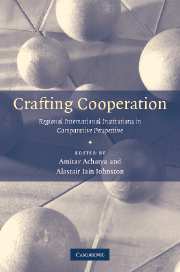Book contents
- Frontmatter
- Contents
- List of tables
- Notes on the contributors
- Acknowledgments
- 1 Comparing regional institutions: an introduction
- 2 Hanging together, institutional design, and cooperation in Southeast Asia: AFTA and the ARF
- 3 International cooperation in Latin America: the design of regional institutions by slow accretion
- 4 Crafting regional cooperation in Africa
- 5 Functional form, identity-driven cooperation: institutional designs and effects in post-Cold War NATO
- 6 Designed to fail or failure of design? The origins and legacy of the Arab League
- 7 Social mechanisms and regional cooperation: are Europe and the EU really all that different?
- 8 Conclusion: institutional features, cooperation effects, and the agenda for further research on comparative regionalism
- Bibliography
- Index
2 - Hanging together, institutional design, and cooperation in Southeast Asia: AFTA and the ARF
Published online by Cambridge University Press: 22 September 2009
- Frontmatter
- Contents
- List of tables
- Notes on the contributors
- Acknowledgments
- 1 Comparing regional institutions: an introduction
- 2 Hanging together, institutional design, and cooperation in Southeast Asia: AFTA and the ARF
- 3 International cooperation in Latin America: the design of regional institutions by slow accretion
- 4 Crafting regional cooperation in Africa
- 5 Functional form, identity-driven cooperation: institutional designs and effects in post-Cold War NATO
- 6 Designed to fail or failure of design? The origins and legacy of the Arab League
- 7 Social mechanisms and regional cooperation: are Europe and the EU really all that different?
- 8 Conclusion: institutional features, cooperation effects, and the agenda for further research on comparative regionalism
- Bibliography
- Index
Summary
Introduction
One of the most fascinating developments in post-Cold War Asia-Pacific is the frenzy of (regional) institution-building that began in the late 1980s. At the intergovernmental level, we witness the founding of the following: Asia-Pacific Economic Cooperation (APEC, 1989), the ASEAN Free Trade Area (AFTA, 1992), the ASEAN Regional Forum (ARF, 1994), and the ASEAN Plus Three forum (APT, 1997). Equally fascinating, the Association of Southeast Asian Nations (ASEAN) – a group of small to middle powers – played a lead role in the creation and maintenance of many of these institutions, in particular the ARF, AFTA, and the APT, while ASEAN's preference for informality and non-binding mechanisms prevailed over American and Australian preferences in the institutional design of APEC. Important too is the enlargement of ASEAN to ten members through the inclusion of Vietnam, Laos, Myanmar, and Cambodia in the 1990s. The reason for ASEAN's leading role in regional institution-building is partly historical, since ASEAN, formed in 1967, was until the 1990s the only regional institution of note in Asia. Hence it seemed natural to build on the strengths and achievements of ASEAN – whether it was the expansion of ASEAN itself, buttressing intra-ASEAN economic cooperation, engaging new partners in financial cooperation through the APT, or reaching out to the great powers in the form of the ARF.
- Type
- Chapter
- Information
- Crafting CooperationRegional International Institutions in Comparative Perspective, pp. 32 - 82Publisher: Cambridge University PressPrint publication year: 2007
- 6
- Cited by



